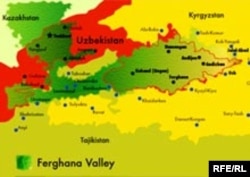(RFE/RL's video journalists talk to Kazakh officials and local residents about the pollution of Central Asia's longest river.)
It can carry carcinogens into rice fields, pass toxins from nursing mothers to newborns, and is seen as a threat to the health and livelihood of the millions of people who live nearby.
It is the water from the Syr Darya, Central Asia's longest river, and second-largest by volume.
By the time it nears the end of a twisting course that takes it through four Central Asian states, the Syr Darya has accumulated such high levels of agricultural runoff such as pesticides and fertilizers, industrial waste, and any number of other contaminants that some are warning that crops irrigated by the river in southern Kyzyl-Orda province should be burned.
And as bad as that sounds, it may be even worse. The dire assessment of the state of Syr Darya's water was made on March 26 at a meeting in Almaty of state-sponsored environmentalists and ecologists, the sort of group one would expect might "sugarcoat" the true extent of the problem.
During the meeting, the deputy director of Kazakhstan's agency for applied ecology, Malik Burlibaev, said that "the Syr Darya is so polluted that water from it should not be used for drinking or for irrigation." Rice harvested in Kyzyl-Orda, he said, was so loaded with cancer-causing agents that it should not be eaten.
Burlibaev claimed that intestinal-cancer rates of residents in Kyzyl-Orda were the highest in Kazakhstan, and that 90 percent of nursing mothers in the province were passing pesticides to their babies through their breast milk.
Orazgul Zhunusova, head of the state's department for expertise and control of the Aral-Syr Darya ecology, confirmed Burlibaev's findings to RFE/RL's Kazakh Service.
Zhunusova said that according to data from the latest of the regular monthly samples her office takes, "the level of biological contamination [human and agricultural waste] of the water for March was 30 percent higher than accepted norms." Gazeta.kz recently reported that the river's water contained high levels of copper, cadmium, and zinc.
A River Runs Through It
The 2,200-kilometer Syr Darya River originates in the mountains of Kyrgyzstan, where it is fed by the Naryn River in the south, and the Kara Darya to the north. From there the Syr Darya passes through some of the most heavily populated areas of Central Asia, including the Ferghana Valley, a fertile agricultural region running across Kyrgyzstan, Uzbekistan, and Tajikistan.
The Syr Darya's path, which once led to the Aral Sea, also takes it through ancient Silk Road cities, such as Namangan and Kokand (in Uzbekistan), Khujand (in Tajikistan), and Turkestan (in Kazakhstan). And the Uzbek capital Tashkent and the southern Kazakh city of Shymkent are located nearby.
Aside from the contributions those and other urban areas make to the pollution of the Syr Darya, factories, plants, and mining operations along the river present formidable environmental hazards. And detergents enter its waters in large part because people along banks wash their clothing and bathe in the river.
By the time the Syr Darya enters Kazakhstan from Uzbekistan several hundred kilometers away from the region where the extreme contamination was registered, Zhunusova says, "it is already contaminated."
Even before the river reaches its halfway point, people know better than to drink from the Syr Darya, although locals near northern Tajikistan's Khujand have been known to fish its waters.
The big question is just how contaminated the river is upstream. Is the water already too dangerous for agricultural use by the time it passes near Tashkent? How contaminated is the Syr Darya by the time it winds through the Ferghana Valley, the most densely populated area in Central Asia?
Bleak Future?
In Kazakhstan's Kyzyl-Orda province, Bigesh Zhakhyp, deputy director of the state water-management department for the province, says that local officials have been doing what they can to reduce the contamination. He says decades of mismanagement have contributed to the current situation, but that there are some positive signs.
Zhakhyp says that the province uses about the same amount of water for irrigation as it did in the 1990s, and that water conservation is improving. He also notes that during the Soviet period, all waste was simply dumped in the river, which is now less common. Also, since chemical fertilizers are no longer provided by the central authorities, they are used more judiciously.
As local resident Gulbarshyn Sonarkyzy notes, if the Syr Darya is no longer used for irrigation, "our fields and gardens will dry up. This is clear."
Also clear is that the dilemma faced by Kyzyl-Orda officials could have broader implications -- fears have been raised that lower crop yields could force Kazakhstan, the only grain exporter in Central Asia, to ban grain exports to its neighbors.
At the conference in Almaty, Burlibaev of the agency for applied ecology characterized the situation as an international problem that calls for an international situation.
But cooperation in the face of desperate circumstances that affect them all has not been a trademark of Central Asian governments, as evidenced by their half-hearted attempts to slow the shrinking of the Aral Sea and their failures to find a middle ground in the ongoing debate over water resources.
Yerzhan Karabek and Sultan-Khan Zhussip of RFE/RL's Kazakh Service contributed to this report



















